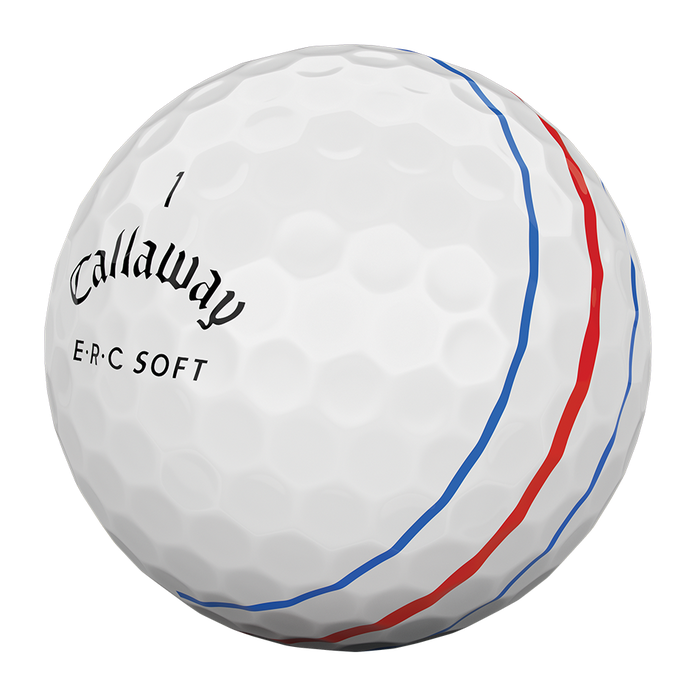Vernier acuity — you know what I mean?
Last month it was coefficient of restitution.
This month it is vernier acuity.
Last month we reported that Bryson DeChambeau had many of the different flagsticks he would encounter at various PGA Tour venues tested for their firmness.
Callaway's new ball with three lines to help with vernier acuity.
DeChambeau, affectionately known as golf’s mad scientist, referred to the firmness testing as coefficient of restitution.
We had to look up the words coefficient and restitution in the dictionary and it seemed they formed an appropriate phrase. We encouraged you to drop in the phrase during a round of golf to impress your friends.
This month’s phrase is vernier acuity.
It was back to the dictionary once again.
The first dictionary did not list the word.
The second dictionary said the word vernier was something about a small, movable, graduated scale running parallel to the fixed graduated scale of a sextant, theodolite, barometer, etc.
Obvious.
Acuity was much easier to understand. It meant: sharpness; acuteness; keenness.
There were even two examples which, no pun intended, made everything clear. The first example was acuity of vision. The second example was acuity of mind.
Okay, so what does vernier acuity refer to?
Ask Phil Mickelson. He’s using it on his golf balls.
Phil will tell you it’s three parallel lines on his ball instead of one to help in the lining up of putts.
Phil will also refer you to Carl Bassi, a professor at the University of Missouri-St. Louis College of Optometry.
In the simplest terms, vernier acuity refers to the ability of the brain to process subtle differences in alignment detected in the eyes.
Obvious.
By having the right kind of multiple reference points (like a centre line flanked by two parallel lines), the brain perceives the straightness of aim better. It’s a technology used in gun sights and the landing strips on aircraft carriers.
Obvious.
Bassi, the professor guy, researched the design with Ray Barrett, an 80-something inventor and retired founder of a St Louis biomedical research firm. Barrett came to Bassi after he started drawing the lines on his golf ball in hope he might see his tee shots better.
“With my group, when we hit a tee shot, the first thing we ask is ‘Where’d it go?’ and the only thing we ever hear is, ‘Well, it sounded good,’ ” Barrett said.
“But we all started putting better, and I wanted to know why this might be working, if it is working.
“When I brought it to [Bassi], he looked at it and said, ‘Well, you’re trending toward vernier acuity.’ I said, ‘Oh, hell, that sounds like a disease.’ ”
On the contrary, Barrett’s lines on the golf ball served to activate in the brain what’s called “hyperacuity,” Bassi said.
“If you just go by the optics of the eye itself, there are just certain limits the eye imposes,” Bassi said.
“We know that with these vernier acuity effects, the hyperacuity exceeds the limit that you would have predicted based on the anatomy of the eye by itself. What we’re doing is we’re taking advantage of this hyperacuity by optimising these parameters.”
You should have been nodding your head in agreement as you read those last few sentences. Maybe you were shaking your head in confusion.
The parameters of the lines include having three lines so that the two outside lines flank the centre line. The distance the lines are apart is crucial In the case of Callaway, the colours are a wide red centre line flanked by thinner blue lines.
Bassi’s lab at the UMSL College of Optometry tested Barrett’s idea by embedding a laser in a golf ball and compared the aiming accuracy of three lines versus the typical single alignment line found on most golf balls. The testing showed a 12 percent improvement in accuracy for the three-lined ball on a 10-foot putt.
Bassi said the lines’ effects work independent of how good your vision is.
“Even for people that don’t have optimum refraction and may not have perfect visual acuity, they still have very, very good hyperacuity,” he said.
“I could imagine someone being tired might be able to function better.”
Phew. I think it’s time to open a bottle of beer.

